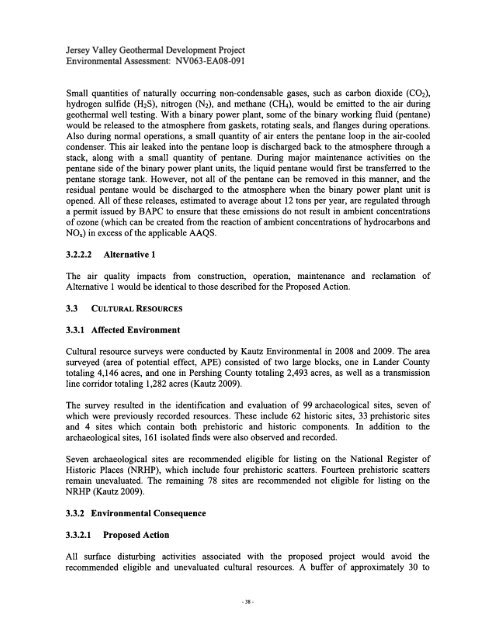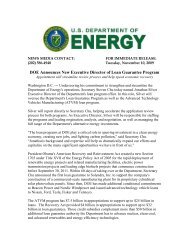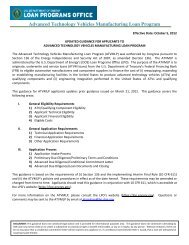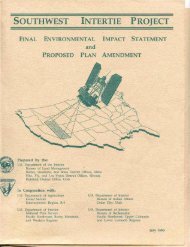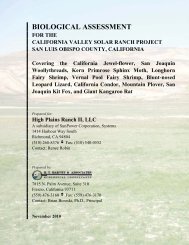Bureau of Land Management's Decision Record and Environmental
Bureau of Land Management's Decision Record and Environmental
Bureau of Land Management's Decision Record and Environmental
Create successful ePaper yourself
Turn your PDF publications into a flip-book with our unique Google optimized e-Paper software.
Jersey Valley Geothermal Development Project<br />
<strong>Environmental</strong> Assessment: NV063-EAO8-091<br />
Small quantities <strong>of</strong> naturally occurring non-condensable gases, such as carbon dioxide (C0 2),<br />
hydrogen sulfide (H2S), nitrogen (N2), <strong>and</strong> methane (CH 4), would be emitted to the air during<br />
geothermal well testing. With a binary power plant, some <strong>of</strong> the binary working fluid (pentane)<br />
would be released to the atmosphere from gaskets, rotating seals, <strong>and</strong> flanges during operations.<br />
Also during normal operations, a small quantity <strong>of</strong> air enters the pentane loop in the air-cooled<br />
condenser. This air leaked into the pentane loop is discharged back to the atmosphere through a<br />
stack, along with a small quantity <strong>of</strong> pentane. During major maintenance activities on the<br />
pentane side <strong>of</strong> the binary power plant units, the liquid pentane would first be transferred to the<br />
pentane storage tank. However, not all <strong>of</strong> the pentane can be removed in this manner, <strong>and</strong> the<br />
residual pentane would be discharged to the atmosphere when the binary power plant unit is<br />
opened. All <strong>of</strong> these releases, estimated to average about 12 tons per year, are regulated through<br />
a permit issued by BAPC to ensure that these emissions do not result in ambient concentrations<br />
<strong>of</strong> ozone (which can be created from the reaction <strong>of</strong> ambient concentrations <strong>of</strong> hydrocarbons <strong>and</strong><br />
NOR) in excess <strong>of</strong> the applicable AAQS.<br />
3.2.2.2 Alternative 1<br />
The air quality impacts from construction, operation, maintenance <strong>and</strong> reclamation <strong>of</strong><br />
Alternative 1 would be identical to those described for the Proposed Action.<br />
3.3 CULTURAL RESOURCES<br />
3.3.1 Affected Environment<br />
Cultural resource surveys were conducted by Kautz <strong>Environmental</strong> in 2008 <strong>and</strong> 2009. The area<br />
surveyed (area <strong>of</strong> potential effect, APE) consisted <strong>of</strong> two large blocks, one in <strong>L<strong>and</strong></strong>er County<br />
totaling 4,146 acres, <strong>and</strong> one in Pershing County totaling 2,493 acres, as well as a transmission<br />
line corridor totaling 1,282 acres (Kautz 2009).<br />
The survey resulted in the identification <strong>and</strong> evaluation <strong>of</strong> 99 archaeological sites, seven <strong>of</strong><br />
which were previously recorded resources. These include 62 historic sites, 33 prehistoric sites<br />
<strong>and</strong> 4 sites which contain both prehistoric <strong>and</strong> historic components. In addition to the<br />
archaeological sites, 161 isolated finds were also observed <strong>and</strong> recorded.<br />
Seven archaeological sites are recommended eligible for listing on the National Register <strong>of</strong><br />
Historic Places (NRHP), which include four prehistoric scatters. Fourteen prehistoric scatters<br />
remain unevaluated. The remaining 78 sites are recommended not eligible for listing on the<br />
NRHP (Kautz 2009).<br />
3.3.2 <strong>Environmental</strong> Consequence<br />
3.3.2.1 Proposed Action<br />
All surface disturbing activities associated with the proposed project would avoid the<br />
recommended eligible <strong>and</strong> unevaluated cultural resources. A buffer <strong>of</strong> approximately 30 to<br />
- 38 -


